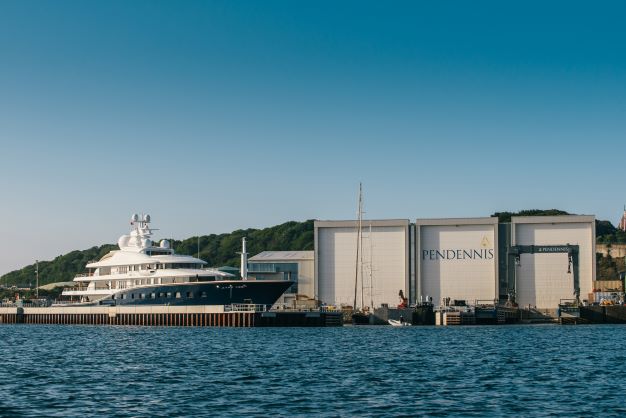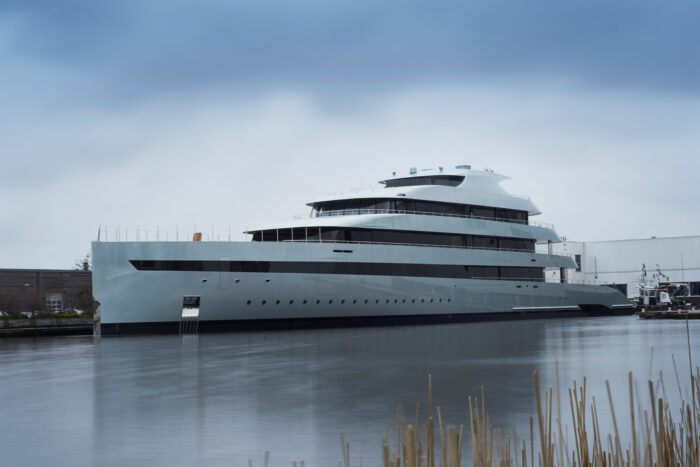Refitting for the future
Is it possible to retrofit a yacht to make it more eco-friendly? What are the best practices and is it worth the environmental and financial costs? Rachel Ingram investigates.

As the world becomes more eco-aware, we’ve seen industries repurposing everything from fashion to furniture. In recent years, yachting has followed suit with modern refits offering environmentally conscious owners an alternative to new builds. Take SURI, the former crab catcher which was literally cut in half and extended by 11m during her conversion into a 63.4m explorer yacht by Bay Ship & Yacht Co. Or AQUILA, which was gutted and transformed into a striking contemporary 85.6m superyacht by Pendennis. There’s no doubt these projects are impressive, but at what cost?
It is the general consensus that refitting, or retro-fitting, a vessel is the eco-alternative to building new. In many cases, this is correct, but it’s a complex subject, as Kevin Laverty, Hill Robinson’s Director of Projects, explains. “A lot of people don’t really understand sustainability as a topic. They think sustainability is only environmental, but sustainability has three pillars: environmental, economic and social.”

85.6m AQUILA, refit by Pendennis Shipyard.
Going green
When talking about ‘eco-friendly’ yachting, many people jump straight to green energy such as hybrid, electric or even hydrogen. And while re-fitting a yacht’s combustion engine with an innovative, ‘greener’ alternative is a commendable option, there are easier and less costly ways to start having an impact. Electrical consumption is a good place to start.
“We often talk about cutting fuel but, looking at the operating profile of your average superyacht, it probably spends 70% of its time sitting in port running generators,” Kevin says. “Look at the number of running hours on a generator versus those on a main engine and you will find a massive disparity. You could have engines on a 15-year-old vessel with less than 10,000 hours on them and generators that have 100 to 120,000 hours on them.”
He advises finding ways to reduce generator hours in small increments, such as switching to LED light bulbs, increasing base AC temperature by a couple of degrees, placing heat-rejecting films on glass windows, or embedding extra insulation into the yacht.
“These are the small wins that, in aggregate, will deliver big savings in hotel load, which ultimately will deliver a bigger impact to your environmental operation than simply changing the main engine,” he says.
The efficiency debate
When it comes to the issues of fuel burn reduction, increasing the efficiency of a yacht is a common solution. The world’s best shipyards have already built a number of ultra-efficient environmentally friendly vessels but applying this technology in a retrofit capacity is complicated.
“You can’t just take a 15-year-old 50m Benetti and put a sail mast on it,” Kevin says, referencing the Oceanco-built hybrid motor sailor BLACK PEARL. Likewise, it would be costly and difficult to, for example, take a twin engine yacht and implement the push-pull arrangement on board SAVANNAH, the world’s first hybrid superyacht, built by Feadship. “It could be done if budget and time were unlimited, but the economics of that just wouldn’t be good,” he says.
“The problem is that people tend to go for the big ticket every time. They go for the biggest number on the table and think if I can make a 10% change, then bang, I’ve done it. But the biggest number on the table is the hardest one to do anything about in retrofit or refit. When you’re talking about refits, the performance of the yacht was dictated a long time ago and, retrospectively, there’s not a whole lot you can do about that in real terms. Instead, it’s all about doing incremental small things to make differences that add up.”
However, there is a sustainability argument to extending the life cycle of a boat, as in the case of former fishing vessel SURI. Referencing ENTOURAGE, a yacht refit managed by Hill Robinson, he says: “At the point we became involved, it was effectively ready to be scrapped. It had so many issues. But our team found a way to economically reinstate the yacht. It took a lot more time because we were working to a very tight budget, but we managed to carry out all the repairs and give the yacht an extension of life. That was a win-win.”

OceanCo’s 106.7m BLACK PEARL, launched in 2016 (© Tom van Oossanen)

Feadship’s 83.5m SAVANAH, launched in 2015
Changing attitudes
The mindset of owners and those working in the industry has changed vastly in the last decade, which has contributed to the rise in refits for sustainability. “Owners are definitely becoming more aware of the environmental impact of what they’re doing. We as an industry are also becoming a lot more aware. We’re under constant attack for our social impact, or perceived lack of social impact. So, leading the way on environmental measures can only be a good thing,” Kevin says.
This attitude extends into every aspect of a refit, from fuel to materials. “When you’re talking about refits, you have to ask, where do the materials come from? What manufacturing processes has it gone through? There’s no point spending your time under a banner of sustainability if you’re buying ‘dirty’ materials,” he says. “The good thing is the younger owners are getting it. They understand and they’re asking, ‘how can I make less of an impact on the planet, but still have my 50m yacht?’”
To determine if a project is positively sustainable, Kevin advises setting your key objectives, looking at the sustainability triangle and carrying out a holistic, multi-layered assessment that looks into every aspect of the job ahead. “The outcome of your sustainability assessment has to be SMART objectives – specific, measurable, achievable, realistic, and timely actual targets. And then you implement those objectives, just as you would any other objective of the project, making it subject to change control.”
While such assessments are not currently law, legislation is catching up. “Refitting for sustainability is happening – and it’s happening because of IMO (the International Maritime Organisation),” Kevin says. “This kind of regulation is brand new in superyachting. There’s not a lot of people carrying out sustainability reviews, but it is coming. I think one day, people will treat sustainability assessments the same way as risk assessments. It’s project management 101.”
Find out more about Hill Robinson’s refit services offering here.
Related News




 Previous Article
Previous Article